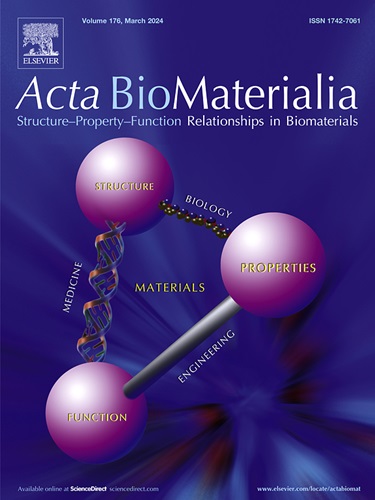严重马凡氏综合征小鼠模型中主动脉微结构重塑和被动生物力学的性别和地区特异性差异与动脉瘤倾向相关
IF 9.4
1区 医学
Q1 ENGINEERING, BIOMEDICAL
引用次数: 0
摘要
马凡氏综合征(MFS)是一种结缔组织疾病,由编码纤维蛋白1的基因突变引起,纤维蛋白1是大弹性动脉中弹性纤维组装和稳定性所必需的糖蛋白。MFS与主动脉瘤相关,通常发生在近端升主动脉,男性预后较差。动脉瘤发展和结果的性别和地区特异性差异的机制尚不清楚。我们量化了4个月大的雄性和雌性Fbn1mgR/mgR(一种严重MFS模型)和野生型小鼠的主动脉几何形状、微观结构重塑和被动生物力学,以确定主动脉几何形状、微观结构重塑、生物力学和动脉瘤扩张之间的相关性。我们发现,动脉瘤扩张与卸载厚度、微观结构重塑(包括弹性纤维的损失、胶原纤维的沉积、细胞核数量的减少)和力学指标(包括生理和离体周向材料刚度)密切相关。多变量混合模型显示,卸载厚度、弹性纤维退化和离体材料刚度预测动脉瘤扩张,调整后R2 = 0.8818。我们的研究结果强调了几何、微观结构重塑和生物力学指标作为MFS患者个性化主动脉瘤诊断和治疗的物理生物标志物的潜力。意义声明:马凡氏综合征(MFS)是一种与主动脉瘤相关的遗传性疾病,具有明显的性别和地区特异性结局。驱动这些变化的机制尚不清楚。我们使用严重MFS小鼠模型(Fbn1mgR/mgR)来探索男性和女性主动脉长度微结构重塑和被动壁力学的差异。我们将这些变化与动脉瘤严重程度联系起来,通过主动脉扩张来量化。我们发现,性别和区域特异性改变在主动脉壁的无负荷厚度、微结构重塑和被动力学特性中发挥关键作用。我们的研究结果表明,力学指标,特别是离体材料刚度,可以作为诊断和治疗主动脉瘤的生物标志物。本文章由计算机程序翻译,如有差异,请以英文原文为准。
Sex- and region-specific differences in microstructural remodeling and passive biomechanics of the aorta correlate with aneurysm propensity in a mouse model of severe Marfan syndrome
Marfan syndrome (MFS) is a connective tissue disorder caused by mutations in the gene that encodes fibrillin-1, a glycoprotein necessary for elastic fiber assembly and stability in the large elastic arteries. MFS is associated with aortic aneurysms that typically occur in the proximal ascending aorta and have worse outcomes in males. Mechanisms for the sex- and region-specific differences in aneurysm development and outcomes are unknown. We quantified aortic geometry, microstructural remodeling, and passive biomechanics of the thoracic ascending, thoracic descending, abdominal suprarenal, and abdominal infrarenal aorta in 4 months old male and female Fbn1mgR/mgR (a model of severe MFS) and littermate wild-type mice to determine correlations between aortic geometry, microstructural remodeling, biomechanics, and aneurysmal dilation. We showed that aneurysmal dilation was strongly correlated with unloaded thickness, microstructural remodeling including loss of elastic fibers, deposition of collagen fibers, and decrease in cell nuclei number, and mechanical metrics including physiologic and ex vivo circumferential material stiffness. A multivariable mixed model showed that unloaded thickness, elastic fiber degradation, and ex vivo material stiffness predicted aneurysmal dilation with an adjusted R2 = 0.8818. Our results highlight the potential of geometric, microstructural remodeling, and biomechanical metrics to serve as physical biomarkers for personalized aortic aneurysm diagnosis and management in MFS.
Statement of significance
Marfan syndrome (MFS) is a genetic disease associated with aortic aneurysms that have distinct sex- and region-specific outcomes. The mechanisms driving these variations are unclear. We used a severe MFS mouse model (Fbn1mgR/mgR) to explore differences in microstructural remodeling and passive wall mechanics along the aortic length in males and females. We correlated these changes with aneurysm severity, as quantified by aortic dilation. We found that sex- and region-specific alterations in unloaded thickness, microstructural remodeling, and passive mechanical properties of the aortic wall play a critical role in aortic dilation. Our findings showed that mechanical metrics, particularly ex vivo material stiffness, may serve as biomarkers for the diagnosis and management of aortic aneurysms.
求助全文
通过发布文献求助,成功后即可免费获取论文全文。
去求助
来源期刊

Acta Biomaterialia
工程技术-材料科学:生物材料
CiteScore
16.80
自引率
3.10%
发文量
776
审稿时长
30 days
期刊介绍:
Acta Biomaterialia is a monthly peer-reviewed scientific journal published by Elsevier. The journal was established in January 2005. The editor-in-chief is W.R. Wagner (University of Pittsburgh). The journal covers research in biomaterials science, including the interrelationship of biomaterial structure and function from macroscale to nanoscale. Topical coverage includes biomedical and biocompatible materials.
 求助内容:
求助内容: 应助结果提醒方式:
应助结果提醒方式:


